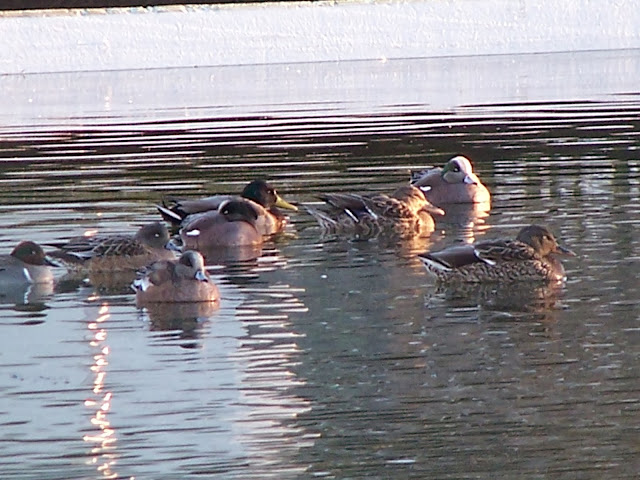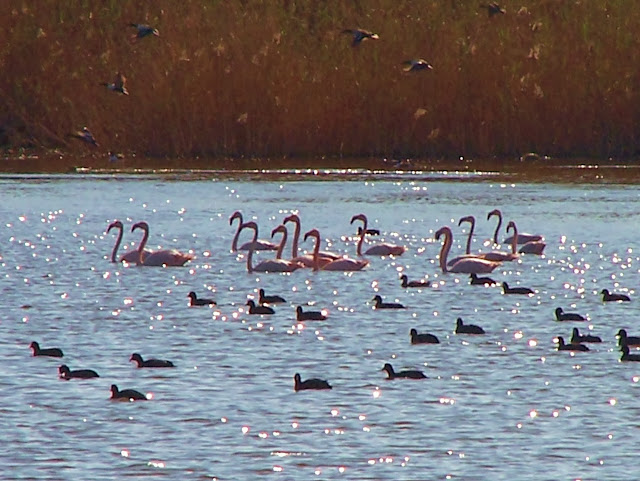 |
| Photos taken in mid November 2013 and show the slopes on the south/ south-east side of Tourkovounia with panoramic views over the Athens Basin. |
Introduction
Tourkovounia (a.k.a. Attikon Alsos; Anchesmos in antiguity) is a very low limestone mountain in the center of the Athens basin, within the city limits of Athens Municipality. Its located at: 38° 0'6.23"North, 23°45'24.52" East. The site is considered one of Athens 7 most important sites for birds in the city of Athens (Kominos et al. 2004). However, this designation is primarily set because the site is rather well birded. My brother-in-law and I have been birding here for many years and have built up a good list (many breeding species, some threatened/protected species etc). So it is basically a distinguished site mainly because it is "better known" than many other parts of the city. In fact, our home is located immediately near the trail-head on the southeast side of this small "mountain-island". Sadly although we have a lot of data from our walks, we have not published much, so I initiate an initial report here.
I have been influenced by the "birding minimum daily requirement idea" promoted by American ornithologist Rob Furgus who recommends frequent birding as a form of therapy. By MDR one strives to see a minimum number of bird species per walk or per day - say 20 species as an MDR (see refrences). So I have started taking detailed notes of birds on informal city walks striving to see as many species as possible on casual walks. Its a simple "look-see method"; and here I provide results for the first 15 walks this winter at my "local patch".
Methods
A very informal look-see method was applied and no particular structure (but walks did not include the landscaped and wooded "Attikon Alsos" park, but mostly the southern and eastern slopes. Each visit-walk was between 20 minutes to 60 minutes of dog-walking birding experience. Some day's effort was more than others - and I believe the effort really defined what was recorded. Notes were kept in the field; daily list and numbers of each species seen were carefully logged.
Nearly all of these look-see walks were with "Teemo" our small terrier; sometimes alone, sometimes with friends and family. Most are really very short walks (2 Km or so only). Elevation gain max: 100 m. Maximum elevation 350 m. or so at upper ridge of Tourkovounia. Usually birding was at about 250 m. or 280 m a.s.l or so. This study was completed during just over a fortnight period (21.12/2013 to 6.1/2014). The weather was very good with some days peaking at 12 or so C and most days were nearly windless.
Results
9,8 species was the average species-list tallied per outing; with a standard deviation of 4.1 (Table 1). After these 15 trials the total list of species recorded in mid-winter is 26 (Table 2). The relative abundance of each speceis is also given in Table 2. Figure 1 shows these results more graphically. The Long-tailed Tit is the only new species that was added to the Tourkovounia site list (which is at roughly 95 spp. as recorded in Kominos et al 2004). Another notable species is the Rock Bunting (about 6 or 8 birds, seen only on three occasions), but this bird is regular each year. Generally, some birds that one would expect are absent (finches, thrushes); several species are unusually rare/scarce (thrushes, finches, tits). The most abundant species in terms of numbers is probably the Chaffinch. A roost of magpies was also discovered (numbering perhaps 100 individuals).
Discussion
The idea of going out and "working" to see as many birds as possible in the neighbourhood green spaces of a major metropolis is immediately attractive. This may act as an incentive to promote the sport of birding, natural history citizen science, creative recreation, and greater ecosystem understanding for biodiversity conservation in the city (i.e promoting birdscaping etc). More casual bird recording such as this may help promote the "minimum daily requirement" number for Athens (20 species per day is promoted in North America by Rob Furgus). So I recommend more birders and naturalists keep lists in Athens and even this casual, semi-quantitative, and unstructured approach can be very informative.
Refrences
- Kominos, Th., Teneketzis, K., Proponas, N., Stavrakas, L, Vlachos, Chr., Vlamis, A,. Zogaris, S. (2004). Athens for the Birds. Educational pamphlet. Hellenic Ornithological Soceity.
http://en.wikipedia.org/wiki/Tourkovounia
- More on the 20 Birds Per Day, Daily Requirement :
http://birdchaser.blogspot.gr/2011/10/20-bird-minimum-daily-requirement.html
https://www.facebook.com/pages/20-Bird-Minimum-Daily-Requirement/155841544511282
Tables and Figures
Table 1. Details of the 15 look-see bird surveys (21.12/2013 to 6.1/2014). Surveys done during the morning (am) and afternoon (pm) are distinguished behind the date.
Visit #...
Species...
Date
1... 10...
21.12 am
2...
10...
22.12 am
3...
12...
25.12 am
4...
17...
26.12 am
5...
9...
26.12 pm
6...
6...
28.12 am
7...
14...
29.12 am
8...
17...
29.12 pm
9...
5...
1.1 am
10...
5...
2.1. am
11...
8...
3.1 am
12...
9...
3.1 pm
13...
11...
4.1 pm
14...
4...
4.1 pm
15...
10...
6.1 pm
Table 2. Total species list recorded between 21.12/2013 and 6.1/2014 during the 15 look-see bird surveys. The modern Greek names are given in brackets and the status of frequency of occurrence generalized specifically for the study-period is in parentheses.
1. Common Chaffinch [Σπίνος] (Common)
2. Blackcap Warbler [Μαυροσκούφης](Common)
3. Chiff-chaff [Δεντροφυλλοσκόπος](Common)
4. Eurasian Magpie [Καρακάξα] (Common)
5. Sardinian Warbler [Μαυροτσιροβάκος](Common)
6. European Robin [Κοκκινολαίμης](Common)
7. Song Thrush (aka Thrush sp.) [Κοινή Τσίχλα ή είδος Τσίχλας](Scarce, difficult to observe)
8. Eurasian Blackbird [Κότσυφας] (Fairly Common)
9. Black Redstart [Καρβουνιάρης](Fairly Common)
10. Rock Dove (feral) [Περιστέρι](Fairly Common)
11. Great Tit [Καλόγερος](Scarce)
12. Grey Wagtail [Σταχτοσουσουράδα] (Scarce, localized)
13. Eurasian Collared Dove [Δεκοχτούρα] (Common)
14. House Sparrow [Σπιτοσπουργίτης](Local, Fairly Common)
15. Dunnock [Θαμοψάλτης](Scarce)
16. Rock Bunting [Βουνοτσίχλονο](Rare, two observations)
17. European Sparrowhawk [Ξεφτερι](Scarce)
18. Common Starling [Ψαρόνι](Local, Fairly Common)
19. Common Kestrel [Βραχοκιρκίνεζο](Local, Fairly Common)
20. Yellow-legged Gull [Μεσογειακός Ασημόγλαρος](Scarce)
21. European Goldfinch [Καρδερίνα] (Rare, single observation)
22. Long-tailed Tit [Αιγίθαλος](Rare, single observation)
23. Greenfinch [Φλώρος](Rare, single observation)
24. Little Owl [Κουκουβάγια](Rare, single observation- one heard)
25. Winter Wren [Τρυποφράχτης](Scarce, three observations)
26. Common Buzzard [Γερακίνα](Rare, single observation)
 |
Fig. 1. Simple histogram of the number of birds recorded per day (from Table 1); generally the three days when larger numbers are recorded is mainly due to increased effort.
|














































